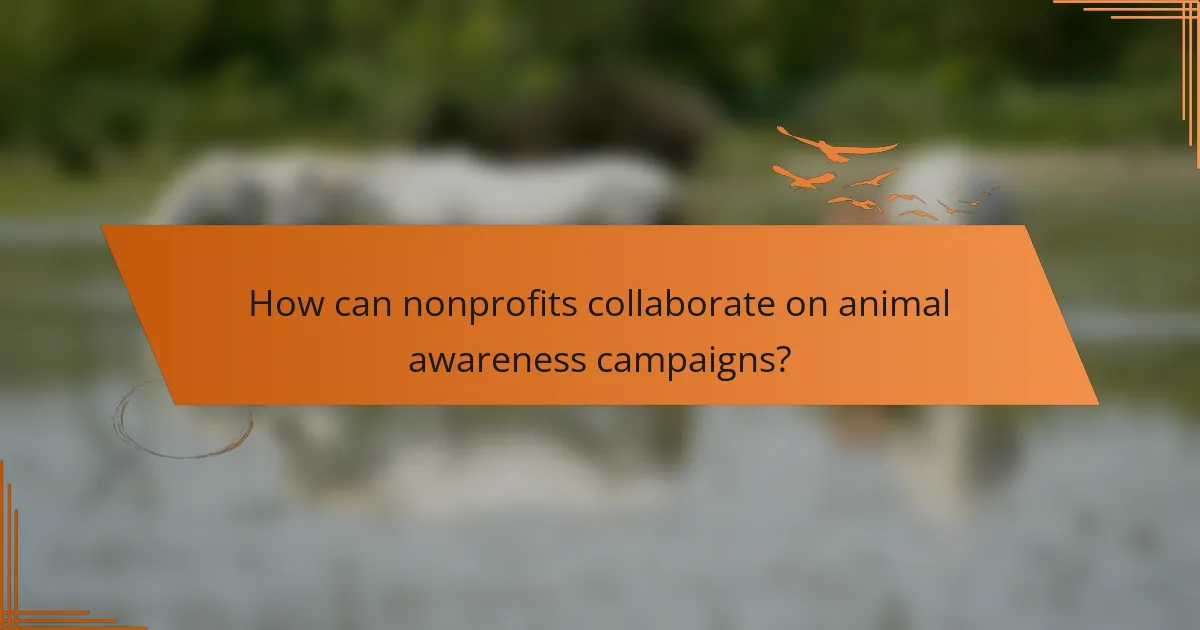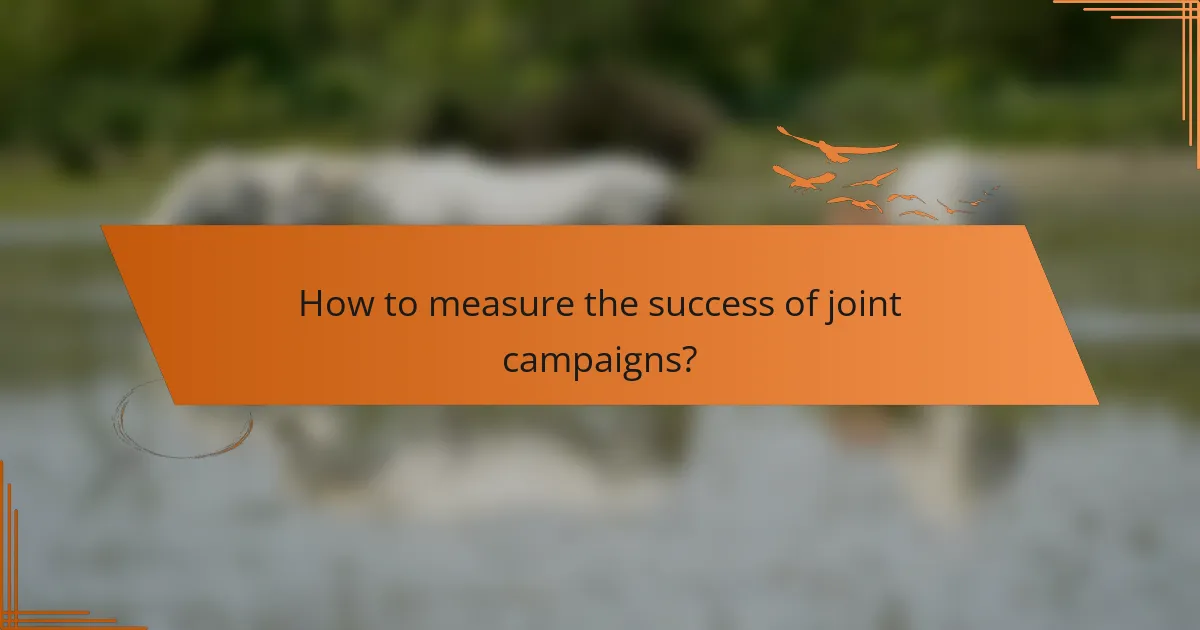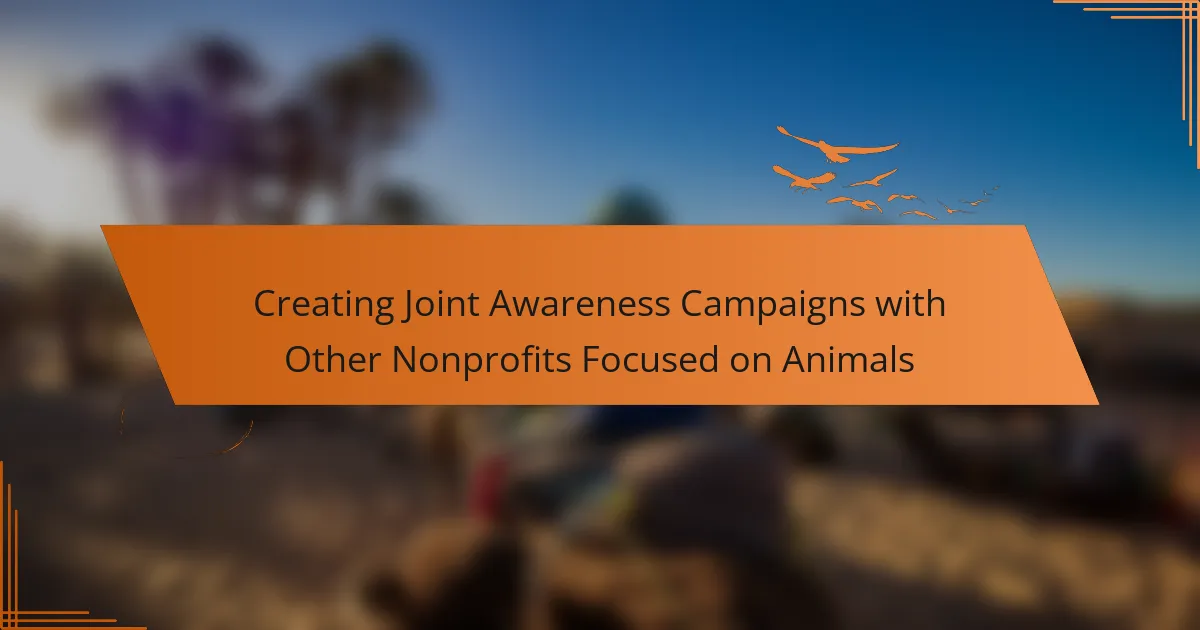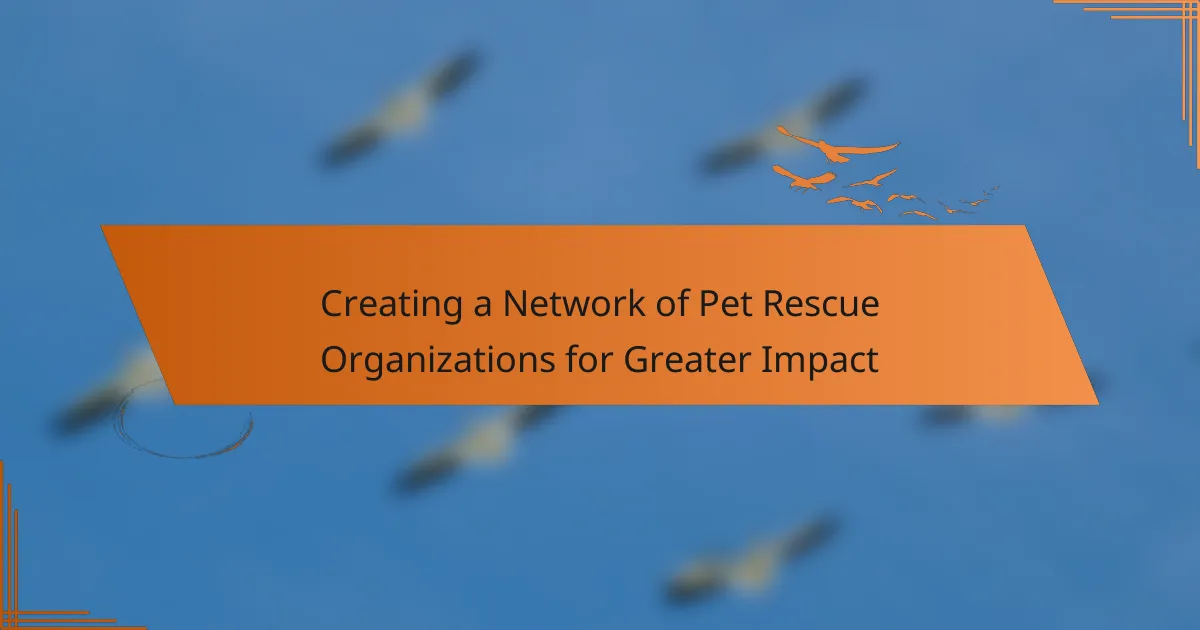Creating joint awareness campaigns with other nonprofits focused on animals can significantly amplify the impact of your efforts. By pooling resources and leveraging each organization’s unique strengths, these collaborations enhance outreach and funding opportunities. Effective strategies such as aligning objectives and employing cross-promotion techniques can lead to greater visibility and a more substantial contribution to animal welfare.

How can nonprofits collaborate on animal awareness campaigns?
Nonprofits can collaborate on animal awareness campaigns by pooling resources, sharing audiences, and leveraging each other’s strengths. This partnership can enhance outreach, increase funding, and create a more significant impact on animal welfare.
Joint fundraising events
Joint fundraising events allow nonprofits to combine their efforts for greater financial support. By organizing events like charity runs, auctions, or benefit concerts, organizations can attract a larger audience and share costs. For instance, a pet adoption day combined with a local animal shelter’s fundraising gala can draw in pet lovers and potential donors alike.
When planning these events, consider the target audience and the types of activities that will engage them. Collaborating on marketing efforts can also boost attendance and donations. Set clear financial goals and agree on how to split the proceeds to avoid misunderstandings.
Shared social media promotions
Shared social media promotions enable nonprofits to amplify their messages by reaching each other’s followers. By creating joint campaigns, such as hashtag challenges or awareness days, organizations can increase visibility and engagement. For example, two nonprofits could run a campaign highlighting adoptable pets, encouraging followers to share posts to raise awareness.
Utilize each organization’s strengths in content creation to produce compelling visuals and messages. Schedule regular posts and engage with followers to maintain momentum. Monitor engagement metrics to assess the effectiveness of the campaign and adjust strategies as needed.
Co-hosting educational workshops
Co-hosting educational workshops provides an opportunity to share knowledge and resources with the community. Nonprofits can collaborate on topics like responsible pet ownership, wildlife conservation, or animal care. This approach not only educates the public but also strengthens the partnership between organizations.
Choose a venue that is accessible and conducive to learning. Promote the workshops through both organizations’ channels to maximize attendance. After the event, gather feedback to improve future workshops and consider offering follow-up resources or materials to attendees.
Collaborative volunteer opportunities
Collaborative volunteer opportunities allow nonprofits to engage their supporters in meaningful ways while maximizing volunteer efforts. By organizing joint volunteer days, such as park clean-ups or animal care events, organizations can create a sense of community among their volunteers. This can lead to increased loyalty and support for both nonprofits.
Clearly define roles and responsibilities for volunteers to ensure a smooth experience. Provide training and resources to equip volunteers with the necessary skills. Recognize and celebrate volunteer contributions to foster a positive environment and encourage ongoing participation.

What are effective strategies for joint campaigns?
Effective strategies for joint campaigns among nonprofits focused on animals include aligning objectives, utilizing each organization’s unique strengths, and employing cross-promotion techniques. These approaches enhance visibility, resource sharing, and overall impact in raising awareness and funds for animal welfare.
Define common goals
Establishing common goals is crucial for the success of joint campaigns. Both organizations should agree on specific objectives, such as raising funds for a particular cause or increasing community engagement. This alignment ensures that efforts are directed towards a shared purpose, maximizing the campaign’s effectiveness.
Consider setting measurable targets, like a specific amount of money to raise or a number of new supporters to engage. Regular check-ins can help maintain focus and adjust strategies as needed to meet these goals.
Leverage each organization’s strengths
Each nonprofit likely has unique strengths that can be utilized in a joint campaign. For instance, one organization may have a strong social media presence, while another excels in community outreach. Identifying and leveraging these strengths can enhance the campaign’s reach and effectiveness.
Collaborate to create a division of labor that plays to each organization’s capabilities. This could mean one group handles online marketing while the other focuses on local events, ensuring that all aspects of the campaign are covered efficiently.
Utilize cross-promotion techniques
Cross-promotion is an effective way to broaden the audience for joint campaigns. Each organization can promote the other’s initiatives through their channels, such as newsletters, social media, and websites. This not only increases visibility but also builds credibility by associating with another trusted entity.
Consider creating joint content, such as blog posts or videos, that highlight both organizations’ missions. Additionally, hosting joint events can attract supporters from both groups, creating a larger community impact and fostering collaboration.

What tools can facilitate collaboration?
Effective collaboration between nonprofits focused on animals can be enhanced using various tools designed for project management, communication, and content sharing. Utilizing the right tools can streamline workflows, improve communication, and ensure that all parties are aligned on campaign goals.
Project management software like Trello
Project management software such as Trello helps teams organize tasks visually, making it easier to track progress and deadlines. By creating boards for different aspects of a joint campaign, organizations can assign tasks, set due dates, and monitor completion status.
When using Trello, consider establishing clear categories for tasks, such as “To Do,” “In Progress,” and “Completed.” This structure allows all team members to quickly assess the project’s status and prioritize their work effectively.
Communication platforms such as Slack
Communication platforms like Slack facilitate real-time discussions and file sharing among team members. These tools allow for the creation of dedicated channels for specific projects or topics, ensuring that conversations remain organized and relevant.
To maximize the effectiveness of Slack, encourage team members to use threads for specific discussions and to share updates regularly. This practice helps keep everyone informed and reduces the chances of important information getting lost in general chat.
Shared content calendars
Shared content calendars are essential for coordinating marketing efforts and scheduling events across multiple organizations. By using a shared calendar, nonprofits can avoid scheduling conflicts and ensure that all promotional activities are aligned with the campaign timeline.
Consider using tools like Google Calendar or Airtable, which allow for easy sharing and collaboration. Set up recurring meetings to review the calendar and make adjustments as needed, ensuring that all partners are on the same page regarding upcoming initiatives.

How to measure the success of joint campaigns?
Measuring the success of joint campaigns with other nonprofits focused on animals involves tracking various metrics that reflect engagement, fundraising, and community sentiment. By analyzing these factors, organizations can determine the effectiveness of their collaborative efforts and identify areas for improvement.
Track engagement metrics
Engagement metrics provide insights into how well the campaign resonates with the audience. Key indicators include social media shares, likes, comments, and website traffic. For example, a successful campaign might see a 30-50% increase in social media engagement compared to previous efforts.
Utilize tools like Google Analytics and social media insights to gather data on user interactions. Regularly reviewing these metrics can help identify which content is most effective and guide future strategies.
Analyze fundraising outcomes
Fundraising outcomes are a critical measure of a campaign’s success. Track total donations, average gift size, and donor retention rates. A well-executed joint campaign might aim for a 20-30% increase in donations compared to individual efforts.
Consider setting specific fundraising goals before the campaign begins and compare actual results against these targets. This approach helps assess the financial impact of the collaboration and informs future fundraising strategies.
Evaluate community feedback
Community feedback is essential for understanding the campaign’s impact on the target audience. Collect qualitative data through surveys, interviews, or focus groups to gauge public sentiment. Look for trends in feedback that highlight strengths and weaknesses of the campaign.
Encouraging participants to share their thoughts can provide valuable insights. Aim for a response rate of at least 10-15% on surveys to ensure the feedback is representative of the broader audience.

What are the challenges of joint campaigns?
Joint campaigns among nonprofits focused on animals face several challenges that can hinder their effectiveness. These challenges include misalignment of goals, resource allocation issues, and communication barriers, all of which require careful consideration to ensure a successful partnership.
Misalignment of goals
Misalignment of goals occurs when the participating organizations have differing objectives or priorities for the campaign. For instance, one nonprofit may prioritize fundraising for animal shelters, while another focuses on wildlife conservation. This can lead to conflicting strategies and diluted messaging.
To address this, it is crucial for organizations to establish a shared vision before launching a campaign. Regular meetings and collaborative planning sessions can help align goals and ensure all parties are on the same page.
Resource allocation issues
Resource allocation issues arise when nonprofits struggle to distribute their limited resources effectively among the campaign partners. This includes financial contributions, volunteer hours, and promotional efforts. If one organization contributes significantly more than others, it can create tension and resentment.
To mitigate this, create a clear resource-sharing agreement that outlines each organization’s contributions and responsibilities. Regularly review this agreement to adjust allocations as needed based on campaign progress and changing circumstances.
Communication barriers
Communication barriers can impede collaboration and lead to misunderstandings among partner organizations. These barriers may stem from differences in organizational culture, communication styles, or even geographical locations. For example, a nonprofit based in a rural area may have different outreach methods compared to an urban organization.
Establishing a dedicated communication plan that includes regular updates and feedback mechanisms can help bridge these gaps. Utilizing collaborative tools like shared documents and project management software can also enhance transparency and keep everyone informed.

How to choose the right nonprofit partners?
Selecting the right nonprofit partners is crucial for the success of joint awareness campaigns focused on animals. Look for organizations that share similar goals, values, and target audiences to maximize impact and reach.
Assess mission alignment
Mission alignment is the foundation of a successful partnership. Ensure that both organizations prioritize animal welfare and have compatible objectives, such as promoting adoption, conservation, or education.
Consider creating a checklist of key mission elements to compare. For example, if one organization focuses on rescue and the other on advocacy, they may complement each other well, but if their missions diverge significantly, collaboration may be challenging.
Engage in open discussions about each organization’s mission and vision. This dialogue can reveal shared values and potential synergies, helping to establish a strong partnership that resonates with both audiences.



